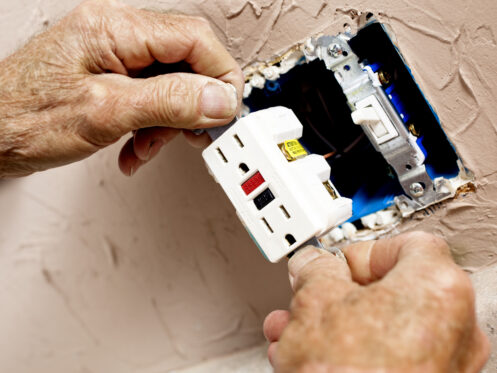As a staple in most modern homes since the late 1940s, electricity is easy to take for granted. Without it, though, much of what we do in our daily lives would become impossible or exceedingly difficult. It’s also easy to forget that electricity is inherently dangerous and that we should handle it with care.
In homes, circuit breakers form one layer of protection that keeps the wires in our walls from overloading and causing fires. But a circuit breaker wouldn’t prevent you from getting a nasty — even fatal — shock from a faulty outlet or a short circuit. Fortunately, there’s a solution for that, too. GFCI outlets can make your home safer and protect you and your loved ones from harm. Here’s what GFCI outlets are, what they do, and where you should have them installed.
What’s a GFCI Outlet?
GFCI stands for ground fault circuit interrupter. They’re a type of quick-reaction circuit breaker that detects ground faults and cuts off the power supply to an outlet. A ground fault refers to any condition where electricity starts flowing to the ground unexpectedly. This can happen if the insulation on a power wire degrades and allows current a place to escape. It can also happen if electricity flows to the ground through water, or worse, through a human being.
GFCI outlets provide excellent protection against electric shocks. Since they first appeared around 1973, GFCI outlets have driven down the rate of residential electrocutions in the U.S. by 83%. That’s impressive, considering how many homes still don’t have GFCI outlets. According to the Consumer Product Safety Commission, more widespread GFCI adoption would prevent a further 47% of current electrocutions.
How Does a GFCI Outlet Work?
GFCI outlets take advantage of the way that electricity naturally flows to detect grounding conditions within a circuit. They monitor the flow of electricity passing through an outlet, looking for any disturbances in the current flow. Many GFCI outlets can detect current variances as tiny as 0.006 amperes. Such disturbances indicate that the electrical current has found an alternate path to the ground. So, when a GFCI outlet senses a current fluctuation, it severs the outlet’s connection to your home’s power supply.
As a homeowner, you can readily identify GFCI outlets because they’ll have two small buttons on their face. One button, which is almost always red, allows you to test your GFCI outlet like you would a smoke detector or a similar safety device. The other button, which should be black, allows you to reset the outlet after it trips in response to a ground fault.
Where You Should Have GFCI Outlets
Over the years, the national building code, which covers all new construction, has slowly expanded its mandate for the installation of GFCI outlets. However, depending on the age of your home, it may not meet all of the latest new construction code standards. The progression of the GFCI mandate happened as follows:
- All exterior outlets in 1973
- All bathroom outlets in 1975
- All garage outlets in 1978
- Outlets within 6 feet of a kitchen sink in 1987
- All basements must have at least one GFCI in 1987
- All crawl space outlets in 1990
- All wet bar outlets in 1993
- Every kitchen outlet serving a countertop in 1996
- All electrically heated floors in 1999
Homes built before 1999 may be missing GFCI outlets in several of the above locations. However, the building code doesn’t require that you add them unless you’re having your home’s wiring updated. It’s a good idea to upgrade many of your home’s vulnerable outlets to add GFCI protection anyway, though. After all, every GFCI outlet you add to your home makes it safer and lowers the odds of anyone in your home suffering electrocution.
If you’d like to add GFCI outlets to your home, you should start with any outlets that could come into contact with water. This means you should prioritize kitchen, bathroom, and laundry room outlets, as well as any outlets on the exterior of your home. These are the outlets most likely to suffer a ground fault. And if you’re planning to add GFCI outlets to your home, you should try to get as many added at once as you can, since it will help you to contain the labor costs involved.
Other Ways to Add GFCI Protection
If your home has more than a handful of outlets that would benefit from GFCI protection, you may worry about the cost involved in adding it. However, there are a few ways that you can extend GFCI protection to your outlets without breaking the bank.
One of them is to add a GFCI outlet as the first outlet on a vulnerable circuit in your home. This will extend GFCI protection to all of the subsequent outlets on that circuit. It’s possible because the majority of residential 120-volt circuits are wired in parallel. So, the current passing through every outlet on the circuit must return through the first outlet in the chain. This means that the single GFCI outlet can sense current disruptions occurring in any of those outlets.
If your home already has circuits protected by GFCI outlets in this way, the protected standard outlets should have a small sticker on them to indicate this. However, if you’ve replaced any of your outlet faceplates over the years, the stickers could be long gone. Fortunately, our electricians can test your circuits to see if any of them have existing GFCI protection. If they find any, they’ll re-label the outlets so you’ll know which have protection and which don’t.
Another cost-effective way to add GFCI protection to multiple outlets is to have one of our expert electricians install a new circuit breaker with built-in GFCI protection on your home’s vulnerable circuits. Depending on your home’s wiring, you might, for example, be able to cover all of your kitchen receptacles or bathroom receptacles with a single new circuit breaker. However, not every home has its outlets neatly arranged into logical circuits. This is especially true if your home has undergone extensive renovations or electrical upgrades after its initial build date. So, you’ll need to discuss your plans with one of our electricians first to determine if this is a feasible and cost-effective option for your home.
Your Residential Electrical Services Team
Since 2004, Huft Home Services has offered expert, reliable electrical services to homeowners throughout the greater Sacramento, CA area. We handle everything from electrical panel upgrades to generators, surge protection, and the installation of GFCI outlets. And that’s not all. We also offer comprehensive HVAC and plumbing services, too. That makes us your one-stop shop for all of your home’s major infrastructure needs. Plus, we pride ourselves on offering uncompromising customer service, which is why we have so many 5-star reviews from our many satisfied customers. So, if you’d like to add GFCI outlets to your home or have any other electrical, plumbing, or HVAC issue you need help with, call Huft Home Services today!



